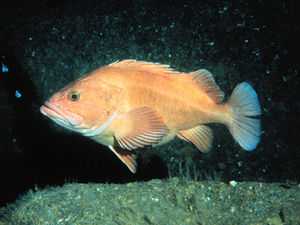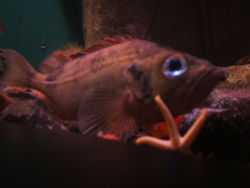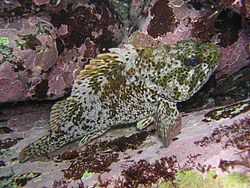Sebastes
| Sebastes Temporal range: 33.9–0Ma Early Oligocene to Present[1] | |
|---|---|
 | |
| Yelloweye rockfish, Sebastes ruberrimus | |
| Scientific classification | |
| Kingdom: | Animalia |
| Phylum: | Chordata |
| Subphylum: | Vertebrata |
| Infraphylum: | Gnathostomata |
| Superclass: | Osteichthyes |
| Class: | Actinopterygii |
| Subclass: | Neopterygii |
| Order: | Scorpaeniformes[2] |
| Family: | Sebastidae |
| Genus: | Sebastes G. Cuvier, 1829 |
| Species | |
|
See text. | |
Sebastes is a genus of fish in the family Sebastidae (though some include this in Scorpaenidae), most of which have the common name of rockfish. A few are called ocean perch, sea perch or redfish instead. Most of the Sebastes species live in the north Pacific, although two (S. capensis and S. oculatus) live in the south Pacific/Atlantic and four (S. fasciatus, S. mentella, S. norvegicus and S. viviparus) live in the north Atlantic. The coast off South California is the area of highest rockfish diversity, with 56 species living in the Southern California Bight.
The fossil record of rockfish goes back to the Miocene, from California and Japan (although fossil otoliths from Belgium, "Sebastes" weileri, may push the record back as far as the Oligocene).
Rockfish are an important sport and commercial fish, and many species have been overfished. As a result seasons are tightly controlled in many areas. Sebastes are sometimes fraudulently substituted for the more expensive red snapper (L. campechanus).[3]
Ecology
Rockfish range from the intertidal zone to almost 3,000 metres (9,800 ft) deep, usually living benthically on various substrates, often (as the name suggests) around rock outcrops. Some rockfish species are very long-lived, amongst the longest-living fish on earth, with several species known to surpass 100 years of age, and a maximum reported age of 205 years for S. aleutianus.[4]
Ecotoxicology, radioecology
Like all carnivores, these fish can bioaccumulate some pollutants or radionuclides as cesium. Highly radioactive rockfish have been caught in a port near Fukushima city, Japan, not far from the Fukushima Daiichi Nuclear Power Plant, nearly two years after the nuclear disaster (ex: 107000 Bq/kg[5] (2013-02-12) ; 116000 Bq/kg[5] (2013-02-13) and 132000Bq/kg[5] (2013-02-13), respectively 1070, 1160 and 1320 more than Japanese standard time (as updated on April 1, 2012[5]).
Species
There are currently 107 recognized extant species in this genus:[6]



_01.jpg)





- Sebastes aleutianus (D. S. Jordan & Evermann, 1898) (Rougheye rockfish)
- Sebastes alutus (C. H. Gilbert, 1890) (Pacific ocean perch)
- Sebastes atrovirens (D. S. Jordan & C. H. Gilbert, 1880) (Kelp rockfish)
- Sebastes auriculatus Girard, 1854 (Brown rockfish, Brown seaperch)
- Sebastes aurora (C. H. Gilbert, 1890) (Aurora rockfish)
- Sebastes babcocki (W. F. Thompson, 1915) (Redbanded rockfish)
- Sebastes baramenuke (Wakiya, 1917)
- Sebastes borealis Barsukov, 1970 (Shortraker rockfish)
- Sebastes brevispinis (T. H. Bean, 1884) (Silvergray rockfish)
- Sebastes capensis (J. F. Gmelin, 1789) (Cape Redfish, Jacopever)
- Sebastes carnatus (D. S. Jordan & C. H. Gilbert, 1880) (Gopher rockfish)
- Sebastes caurinus J. Richardson, 1844 (Copper rockfish)
- Sebastes cheni Barsukov, 1988 (Japanese white seaperch)
- Sebastes chlorostictus (D. S. Jordan & C. H. Gilbert, 1880) (Greenspotted rockfish)
- Sebastes chrysomelas (D. S. Jordan & C. H. Gilbert, 1881) (Black-and-yellow rockfish)
- Sebastes ciliatus (Tilesius, 1813) (Dusky rockfish)
- Sebastes constellatus (D. S. Jordan & C. H. Gilbert, 1880) (Starry rockfish)
- Sebastes cortezi (Beebe & Tee-Van, 1938) (Cortez rockfish)
- Sebastes crameri (D. S. Jordan, 1897) (Darkblotched rockfish)
- Sebastes dallii (C. H. Eigenmann & Beeson, 1894) (Calico rockfish)
- Sebastes diploproa (C. H. Gilbert, 1890) (Splitnose rockfish)
- Sebastes elongatus Ayres, 1859 (Greenstriped rockfish)
- Sebastes emphaeus (Starks, 1911) (Puget Sound rockfish)
- Sebastes ensifer L. C. Chen, 1971 (Swordspine rockfish)
- Sebastes entomelas (D. S. Jordan & C. H. Gilbert, 1880) (Widow rockfish)
- Sebastes eos (C. H. Eigenmann & R. S. Eigenmann, 1890) (Pink rockfish)
- Sebastes exsul L. C. Chen, 1971 (Buccaneer rockfish)
- Sebastes fasciatus D. H. Storer (fr), 1854 (Acadian redfish, Atlantic redfish)
- Sebastes flammeus (D. S. Jordan & Starks, 1904)
- Sebastes flavidus (Ayres, 1862) (Yellowtail rockfish)
- Sebastes gilli (R. S. Eigenmann, 1891) (Bronzespotted rockfish)
- Sebastes glaucus Hilgendorf, 1880 (Gray rockfish)
- Sebastes goodei (C. H. Eigenmann & R. S. Eigenmann, 1890) (Chilipepper rockfish)
- Sebastes helvomaculatus Ayres, 1859 (Rosethorn rockfish)
- Sebastes hopkinsi (Cramer, 1895) (Squarespot rockfish)
- Sebastes hubbsi (Matsubara, 1937)
- Sebastes ijimae (D. S. Jordan & Metz, 1913)
- Sebastes inermis G. Cuvier, 1829 (Japanese red seaperch)
- Sebastes iracundus (D. S. Jordan & Starks, 1904)
- Sebastes itinus (D. S. Jordan & Starks, 1904)
- Sebastes jordani (C. H. Gilbert, 1896) (Shortbelly rockfish)
- Sebastes joyneri Günther, 1878
- Sebastes kawaradae (Matsubara, 1934)
- Sebastes kiyomatsui Kai & Nakabo, 2004
- Sebastes koreanus I. S. Kim & W. O. Lee, 1994
- Sebastes lentiginosus L. C. Chen, 1971 (Freckled rockfish)
- Sebastes levis (C. H. Eigenmann & R. S. Eigenmann, 1889) (Cowcod)
- Sebastes longispinis (Matsubara, 1934)
- Sebastes macdonaldi (C. H. Eigenmann & Beeson, 1893) (Mexican rockfish)
- Sebastes marinus Linnaeus, 1758 (Rose fish, Atlantic redfish)
- Sebastes maliger (D. S. Jordan & C. H. Gilbert, 1880) (Quillback rockfish)
- Sebastes matsubarae Hilgendorf, 1880 (Rose fish, Red bream)
- Sebastes melanops Girard, 1856 (Black rockfish, Black seaperch)
- Sebastes melanosema R. N. Lea & Fitch, 1979 (Semaphore rockfish)
- Sebastes melanostomus (C. H. Eigenmann & R. S. Eigenmann, 1890) (Blackgill rockfish)
- Sebastes mentella Travin, 1951 (Deepwater redfish, Beaked redfish, Atlantic redfish)
- Sebastes miniatus (D. S. Jordan & C. H. Gilbert, 1880) (Vermilion rockfish)
- Sebastes minor Barsukov, 1972
- Sebastes moseri Eitner, 1999 (Whitespeckled rockfish)
- Sebastes mystinus (D. S. Jordan & C. H. Gilbert, 1881) (Blue rockfish)
- Sebastes nebulosus Ayres, 1854 (China rockfish)
- Sebastes nigrocinctus Ayres, 1859 (Tiger rockfish)
- Sebastes nivosus Hilgendorf, 1880
- Sebastes norvegicus (Ascanius, 1772) (Golden redfish, ocean perch, red perch)
- Sebastes notius L. C. Chen, 1971
- Sebastes oblongus Günther, 1877
- Sebastes oculatus Valenciennes, 1833 (Patagonian redfish)
- Sebastes ovalis (Ayres, 1862) (Speckled rockfish)
- Sebastes owstoni (D. S. Jordan & W. F. Thompson, 1914)
- Sebastes pachycephalus Temminck & Schlegel, 1843
- Sebastes paucispinis Ayres, 1854 (Bocaccio rockfish)
- Sebastes peduncularis L. C. Chen, 1975
- Sebastes phillipsi (Fitch, 1964) (Chameleon rockfish)
- Sebastes pinniger (T. N. Gill, 1864) (Canary rockfish)
- Sebastes polyspinis (Taranetz & Moiseev, 1933) (Northern rockfish)
- Sebastes proriger (D. S. Jordan & C. H. Gilbert, 1880) (Redstripe rockfish)
- Sebastes rastrelliger (D. S. Jordan & C. H. Gilbert, 1880) (Grass rockfish)
- Sebastes reedi (Westrheim & Tsuyuki, 1967) (Yellowmouth rockfish)
- Sebastes rosaceus Ayres, 1854 (Rosy rockfish)
- Sebastes rosenblatti L. C. Chen, 1971 (Greenblotched rockfish)
- Sebastes ruberrimus (Cramer, 1895) (Yelloweye rockfish)
- Sebastes rubrivinctus (D. S. Jordan & C. H. Gilbert, 1880) (Flag rockfish)
- Sebastes rufinanus R. N. Lea & Fitch, 1972 (Dwarf Red rockfish)
- Sebastes rufus (C. H. Eigenmann & R. S. Eigenmann, 1890) (Bank rockfish)
- Sebastes saxicola (C. H. Gilbert, 1890) (Stripetail rockfish)
- Sebastes schlegeli Hilgendorf, 1880 (Korean rockfish)
- Sebastes scythropus (D. S. Jordan & Snyder, 1900)
- Sebastes semicinctus (C. H. Gilbert, 1897) (Halfbanded rockfish)
- Sebastes serranoides (C. H. Eigenmann & R. S. Eigenmann, 1890) (Olive rockfish)
- Sebastes serriceps (D. S. Jordan & C. H. Gilbert, 1880) (Treefish)
- Sebastes simulator L. C. Chen, 1971 (Pinkrose rockfish)
- Sebastes sinensis (C. H. Gilbert, 1890) (Blackmouth rockfish)
- Sebastes spinorbis L. C. Chen, 1975
- Sebastes steindachneri Hilgendorf, 1880
- Sebastes swifti (Evermann & Goldsborough, 1907)
- Sebastes taczanowskii Steindachner, 1880 (White-edged rockfish, Ezo seaperch)
- Sebastes thompsoni (D. S. Jordan & C. L. Hubbs, 1925)
- Sebastes trivittatus Hilgendorf, 1880
- Sebastes umbrosus (D. S. Jordan & C. H. Gilbert, 1882) (Honeycomb rockfish)
- Sebastes variabilis (Pallas, 1814)
- Sebastes variegatus Quast, 1971 (Harlequin rockfish)
- Sebastes varispinis L. C. Chen, 1975
- Sebastes ventricosus Temminck & Schlegel, 1843 (Japanese black seaperch)
- Sebastes viviparus Krøyer, 1845 (Norway redfish)
- Sebastes vulpes Döderlein (de), 1884 (Fox jacopever)
- Sebastes wakiyai (Matsubara, 1934)
- Sebastes wilsoni (C. H. Gilbert, 1915) (Pygmy rockfish)
- Sebastes zacentrus (C. H. Gilbert, 1890) (Sharpchin rockfish)
- Sebastes zonatus L. C. Chen & Barsukov, 1976
References
- ↑ Sepkoski, Jack (2002). "A compendium of fossil marine animal genera". Bulletins of American Paleontology 364: p.560. Retrieved 2007-12-25.
- ↑ "Scorpaeniformes". Paleobiology Database. Retrieved November 15, 2012.
- ↑ "Regulatory Fish Encyclopedia". U.S. Food and Drug Administration. Retrieved 21 August 2013.
- ↑ Cailliet, G.M., Andrews, A.H., Burton, E.J., Watters, D.L., Kline, D.E., Ferry-Graham, L.A. (2001). "Age determination and validation studies of marine fishes: do deep-dwellers live longer?". Exp. Gerontol. 36 (4–6): 739–764. doi:10.1016/S0531-5565(00)00239-4. PMID 11295512.
- ↑ 5.0 5.1 5.2 5.3 TEPCO (2013), [Nuclide Analysis Results of Fish and Shellfish (The Ocean Area Within 20km Radius of Fukushima Daiichi NPS <1/13>] 2013-02-28 (accessed 2013-03-19)
- ↑ Froese, Rainer, and Daniel Pauly, eds. (2012). Species of Sebastes in FishBase. December 2012 version.
- Milton S. Love, Mary Yoklavich, Lyman K. Thorsteinson, (2002), The Rockfishes of the Northeast Pacific, University of California Press
External links
| Wikimedia Commons has media related to Sebastes. |
